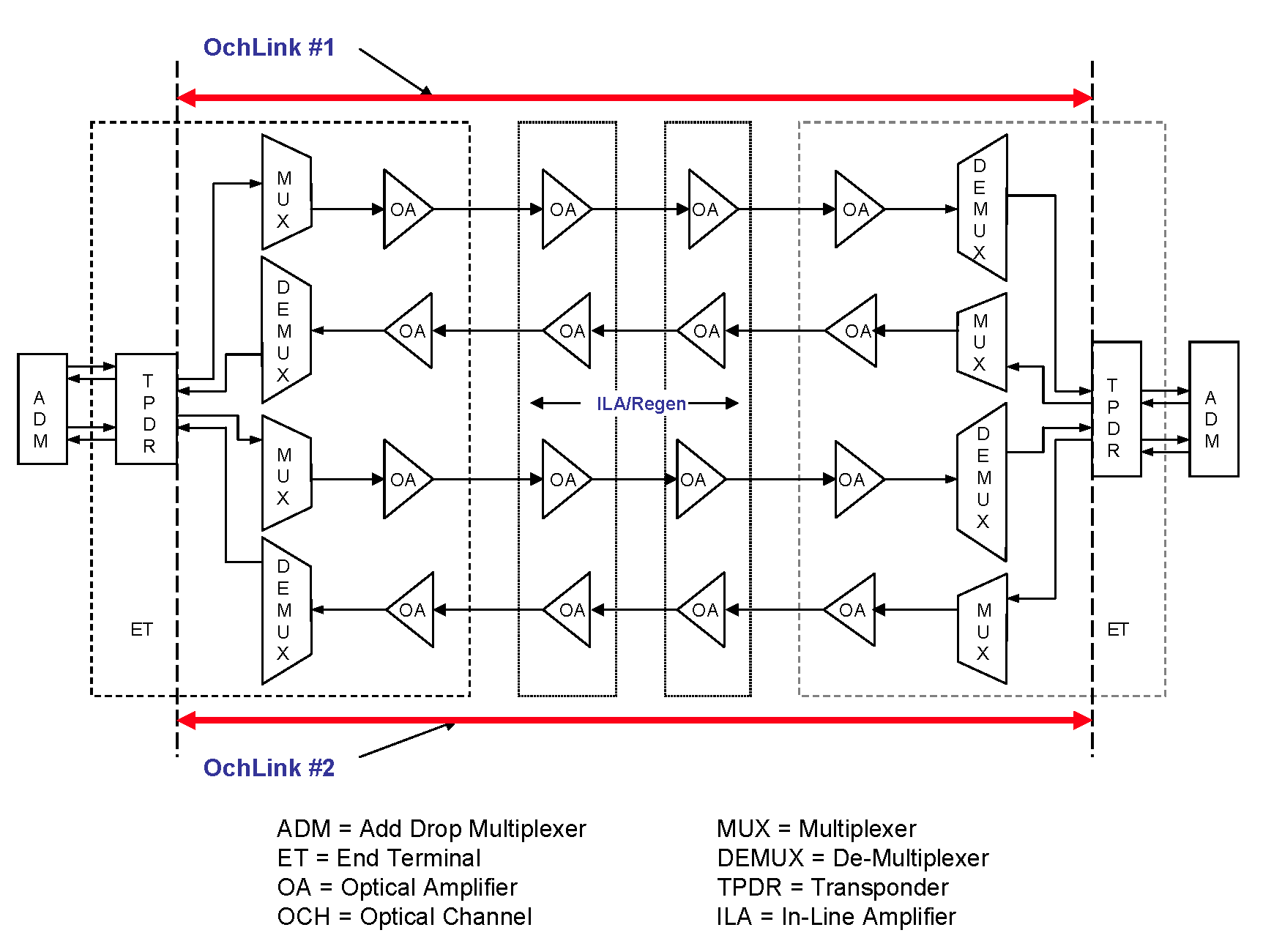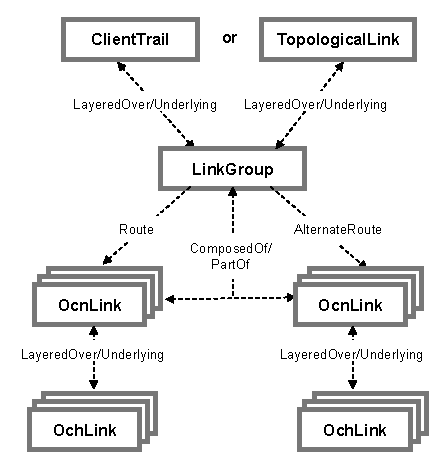1+1 ClientCircuit/TopologicalLink Protection protects WDM wavelength service and SONET/SDH traffic over WDM networks. Wavelength service is carried via the ClientCircuit entity and SONET/SDH traffic is carried via the TopologicalLink entity.
A ClientCircuit or TopologicalLink may ride over several logical and physical entities. When some of those entities duplicate the same segment of the route between OcnLinks or OchLinks, the discovery adapter puts them in a protection group which is modeled as a LinkGroup entity. This allows for redundancy in the service underlaying the ClientCircuit or TopologicalLink.
WDM protection with duplicate OcnLinks shows two OcnLinks both spanning the route from the input of one transponder (TransponderInOcnPort) to the output of another transponder (TransponderOutOcnPort). The discovery adapter insures that none of the equipment in the working route is shared with the protection route.
In the OcnLink protection scheme, the LinkGroup is composed of OcnLinks. The ClientTrail or TopologicalLink is layered over the LinkGroup. The OcnLinks are layered over one or more OchLinks which is a logical connection between multiplexers/demultiplexers. See Classes and relationships used in 1+1 ClientCircuit/TopologicalLink OcnLink protection.
In the OchLink protection scheme, the LinkGroup is composed of OchLinks. An OcnLink is layered over the LinkGroup. Underlaying the OchLinks are one or more FiberLink objects, the lowest level in the architecture. The connections between the add-drop multiplexer (ADM) and the transponders (TPDR) are FiberLinks underlaying the OcnLink.
WDM protection with duplicate OchLinks shows two OchLinks spanning the same route from the input of one multiplexer (TransponderInOchPort) to the output of a demultiplexer (TransponderOutOchPort). Like OcnLinks, the OchLinks must have unique routes with no shared equipment.
The FiberLinks connecting the transponders to the mux/demuxers is part of OchLink and underlays the OchLink.

In the 1+1 ClientCircuit/TopologicalLink protection scheme, switching is handled by negotiation between the transponders.
When a failure or fault occurs on a logical or physical entity that underlays the ClientCircuit or TopologicalLink, if it is part of a LinkGroup, the services layered over the entity receive an “AtRisk” notification, as does the LinkGroup. The “AtRisk” event is propagated to all layers from the LinkGroup to the wavelength service or TopologicalLink.
Only in the event of a failure of all entities in a protection group, will the event notification be “Down” for the TopologicalLink or “ServiceUnavailable” for the ClientCircuit. This notification will also be propagated to all entities layered over the entities in the LinkGroup.
Classes and relationships used in 1+1 ClientCircuit/TopologicalLink OcnLink protection shows the classes and relationships used to model the 1+1 ClientCircuit/ TopologicalLink protection scheme with redundant OcnLinks. The LinkGroup underlays a ClientTrail for wavelength service or a TopologicalLink for SONET/SDH traffic. The LinkGroup is composed of a route and alternate route each of which are layered over OchLinks.
Classes and relationships used in 1+1 ClientCircuit/TopologicalLink OchLink protection shows the classes and relationships used to model the 1+1 ClientCircuit/ TopologicalLink protection scheme with redundant OchLinks. The LinkGroup underlays a OcnLink. The LinkGroup is composed of a route and alternate route each of which are layered over FiberLinks.

